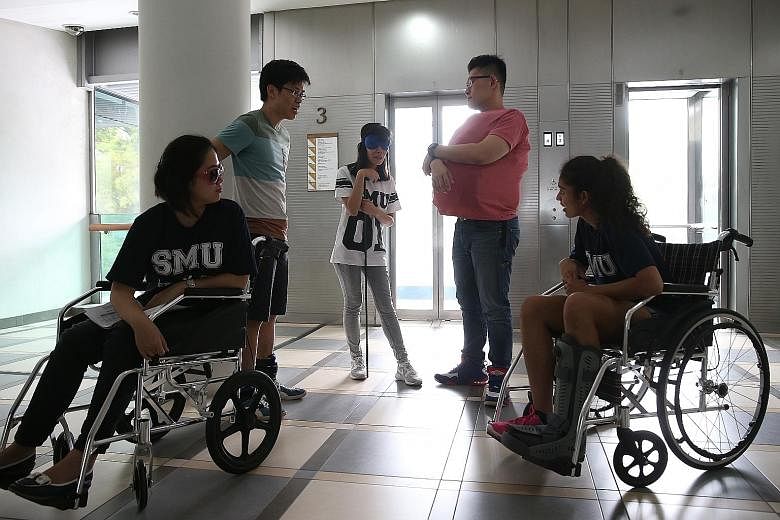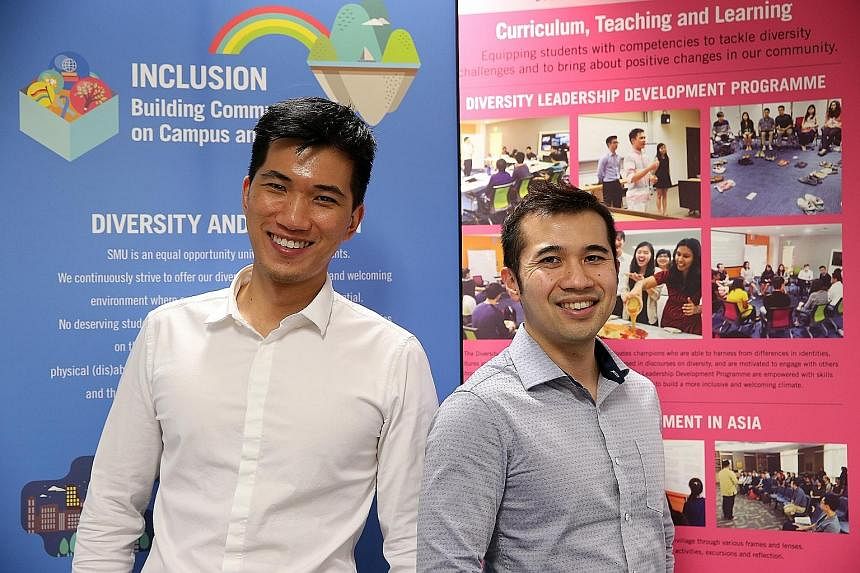One afternoon earlier this month, 40 Singapore Management University (SMU) students spent an hour moving around their campus in a way they were not accustomed to. Some put on ankle weights coupled with ear plugs, others had on foggy glasses and sat in wheelchairs, and a few wore blindfolds or heavy backpacks on the front of their bodies.
These students were wearing props to simulate what it might feel like to have certain disabilities or physical conditions, including leg injuries, old age, bad eyesight, pregnancy and poor hearing. They were split into six groups, and had to work together to finish four tasks, such as buying snacks at the foodcourt and looking for a book in the library.
Part of a course on diversity, the exercise was aimed at instilling empathy in students for those who have to deal with disabilities for real.
"Our objective is for them to appreciate and be aware of the diversity in their surroundings so they will be able to appreciate those differences as assets rather than liabilities," said Assistant Professor Hoon Chang Yau.
Prof Hoon started the Managing Diversity in Asia course last year with Mr Ho Jack Yong, SMU assistant director of diversity and inclusion, to help students learn greater cultural sensitivity when it comes to differences between people across the globe. Managing Diversity in Asia has grown in popularity, with 20 students on the waiting list. It is on the list of SMU-X courses, which teach through real-world projects instead of seminars and lectures.
This year, the lecturers added the disability simulation to the course. Students also work with organisations like the SPD, formerly the Society for the Physically Disabled, and the Harmony Centre on issues such as employment of people with disabilities and interfaith dialogues.
Student Jane Wang, 23, who is majoring in sociology and economics, said she applied for the course as last year's students recommended it. Ms Wang, who will join Singtel as a management associate in July, spent an hour with blindfolds on and was led around by her "pregnant" coursemate Ryan Hoon, 23.
The experience was isolating, she said. "I realise a lot of sharing is based on sight. I was unable to join in the conversation on queues being long... It taught me to think critically about the things around me and how I take them for granted."
At one point, the group took a wefie, causing her to blurt out: "Where do I look?"
In the post-activity discussion, students reported feeling frustration and fear, and encountering being stared at. Many realised that while the campus had lifts and ramps, they were out of the way.
None of the groups completed their tasks in that hour. They estimated that they would have taken half the time if they could move around in the way they usually did.
Despite the learning points, such simulations can be controversial, such as when Singapore Island Country Club's poverty simulation stirred online debate last month, with many calling it patronising.
Acknowledging this, Mr Ho said in his debrief to the class: "Don't walk away from today's simulation with the simplistic view that this is disability. What you guys experienced was really just a glimpse of what it might be like to have a disability."
Still, it was an important experience. Mr Ho told The Sunday Times: "The first step is really empathy, right? Without empathy, you won't even try to understand people who are different from you. I guess simulation is useful in sparking the first interest and getting them interested to find out more."
Mr Samuel Soh, 26, an engineer who has a degenerative condition called avascular necrosis, said: "I think it is useful if participants go into it with the right mindset and the simulation doesn't degenerate into a dog and pony show. A greater degree of empathy is always good."



